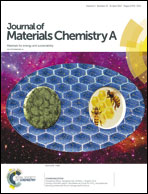Full-cell quinone/hydroquinone supercapacitors based on partially reduced graphite oxide and lignin/PEDOT electrodes†
Abstract
The development of new, scalable and inexpensive materials for low-cost and sustainable energy storage devices is intensely pursued. The combination of redox active biopolymers with electron conducting polymers has shown enhanced charge storage properties. However, their performance has just been investigated at the electrode level. Herein, we move a step further by assembling full-cell supercapacitors based on natural lignin (Lig) and partially reduced graphite oxide (prGrO) electrode materials. Both materials evidenced that quinone/hydroquinone redox moieties are able to store and release charge reversibly. The redox properties of lignin were improved by combining it with poly(3,4-ethylenedioxythiophene) (PEDOT). Analysis of the capacitive contributions to the charge storage proved that PEDOT enhanced the lignin's capacitive contribution to the current by 22%. The capacitive contributions were equal to 66% and 75% in Lig/PEDOT blend and prGrO electrodes, respectively. We also show for the first time that by distributing equally charges in carbon–biopolymer composite electrodes, a higher capacitance retention, up to 79% after 1000 cycles, is achieved.



 Please wait while we load your content...
Please wait while we load your content...